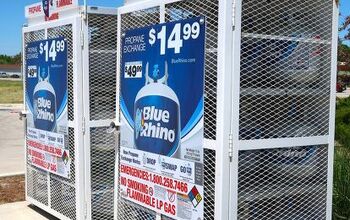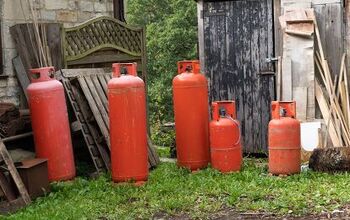Can You Overfill A Propane Tank? (Find Out Now!)

If you regularly use propane tanks, you may wonder whether it’s possible to overfill them. You might know that it can be dangerous to let your propane tank run empty, but what about overfilling it? It’s important to know the basics about overfilled propane tanks because they can be a safety and fire hazard.
It’s possible, but not common, to overfill propane tanks because most have overfill protection devices that prevent overfilling. If your propane tank is overfilled, you might smell propane, hear a hissing noise, and notice a released relief valve. If you believe your propane tank is overfilled, remove all ignition sources in the area and call your propane provider.
This article will cover the “80% fill rule” for propane tanks, as well as how to avoid overfilling. We’ll also discuss how to tell whether your propane tank is overfilled and what you should do if it happens.
Do You Need Water or Fuel Tank Installation or Replacement?
Get free, zero-commitment quotes from pro contractors near you.

What Is The 80% Fill Rule For Propane Tanks?
A propane tank should never be filled to 100% because this doesn’t leave room for gas expansion. Propane expands and contracts in response to changes in temperature. Therefore, the rule of thumb is to fill propane tanks to 80% rather than 100%.
By filling a propane tank only to 80%, there’s plenty of room for the propane to expand. However, there are some exceptions to this rule. For example, if you have an underground tank, your propane supplier may fill it more than 80%.
This is because the surrounding soil insulates the underground tank. Therefore, high temperatures don’t have as much of an effect on it as they would if it was aboveground. This means less propane expansion and less need for extra space in the tank.
How Can You Avoid Overfilling A Propane Tank?
There is a device specifically meant to keep you from overfilling your propane tank. This device is called an OPD cylinder valve. OPD stands for Overfill Protection Device or Overfilling Prevention Device.
You can identify an OPD cylinder valve by its triangular hand wheel at the top of the valve. This device operates inside the tank and is similar to a float valve in a toilet. The float is activated as the liquid propane rises. Once it reaches a certain level (typically 80%), it stops the flow of propane into the tank.
In January 2003, the National Fire Protection Association made a new requirement regarding OPD valves. It stated that all propane tanks between four and 40 pounds must be equipped with an OPD. This regulation cuts back on safety and fire hazards caused by overfilled propane tanks.
Is It Common To Overfill A Propane Tank?
While it’s possible to overfill a propane tank, it’s very rare overall. This is because the vast majority of propane tanks have safety measures in place. It’s uncommon to find a propane tank that doesn’t have an overfill protection device.
Signs Of Overfilled Propane Tank
It’s always wise to know the signs that a propane tank has been overfilled. Usually, the smell of propane will be your first sign that something is amiss. You might also notice that your relief valve is released.
Another sign of an overfilled propane tank is a hissing noise. This sound is propane leaving the tank. A final sign that the gauge might be high after the tank is filled.
What Happens When A Propane Tank Is Overfilled?
The worst-case scenario with an overfilled propane tank is that it explodes. But what’s much more likely to happen is that your tank will start leaking. A leak is still a safety hazard, and it wastes propane and money.
What Should You Do If Your Propane Tank Is Overfilled?
If your propane tank is overfilled, the first thing you should do is clear the area. Ensure that there aren’t any ignition sources close by. Call your propane provider as soon as possible to handle the situation. Alternatively, if you have experience with propane tanks, you may be able to bleed the tank yourself.
How To Bleed An Overfilled Propane Tank
It’s not recommended to bleed an overfilled propane tank if you don’t have experience doing so. To learn more about the process, you can find a general outline of each step below.
Step 1: Check The Area
Before you bleed the tank, make sure you’re in an area with open air. Double-check for any flames or sparks in the immediate area. This cuts back on the risk of a fire.
Step 2: Open Bleeder Valve
Next, you’ll open the propane tank’s bleeder valve. This valve is connected to a dip tube that goes into the tank. By opening the valve, excess propane is able to squirt out of the tank.
Step 3: Let Excess Propane Escape
After opening the bleeder valve, you’ll need to wait and let all of the excess propane escape. You’ll be able to see liquid propane spouting from the valve until the level falls to around 80%. At this point, you’ll see bursts of vapor that begin to escape from the bleeder valve.
Step 4: Shut The Bleeder Valve
Once you’ve noticed vapor rather than liquid coming out of the bleeder valve, it’s time to shut it. In most cases, the bleeding process only takes a few minutes. However, in extreme scenarios, it could take as long as a couple of hours.
Do You Need Water or Fuel Tank Installation or Replacement?
Get free, zero-commitment quotes from pro contractors near you.

Related Questions
Is an overfilled propane tank dangerous?
Yes, an overfilled propane tank can be dangerous. It can be at risk of exploding, but the most likely result is that it will begin to leak. Propane leaks can be a safety and fire hazard.
What happens if a propane tank is overfilled?
An overfilled propane tank is at risk of explosion. However, explosions are very rare. What is more likely is that the overfilled propane tank will begin to leak.
Is a propane tank liquid or gas?
The propane inside a propane tank is a liquid. However, as it leaves the tank, it takes on a gaseous or vapor form.

With a lifelong passion for writing plus strong enthusiasm for home improvement and DIY projects, joining the team at Upgraded Home was an easy choice. Jessica Allen likes to share helpful information with current and aspiring homeowners. Aside from writing, Jessica loves doing yoga, playing the piano, and dabbling in graphic design.
More by Jessica Allen



























